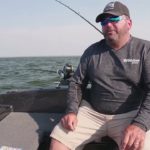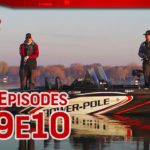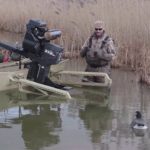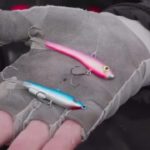Going Vertical
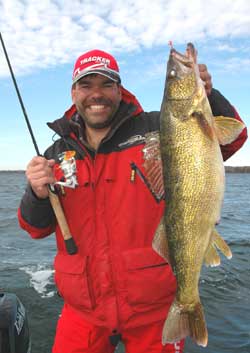 Could you possibly picture a better way to spend a beautiful, crisp November morning than drifting down a peaceful river catching walleyes by the bucket-load. Late in the season, rivers offer some of the most consistent fishing for walleyes you’re likely to find. While the river bite is typically not the “hot bite” it is in the spring, plenty of action awaits the sportsman that chooses a rod and reel over a shotgun and duck blind. It can be a “numbers game”, as well as a “trophy fish” opportunity, and that makes for a great time to be on the water.
Could you possibly picture a better way to spend a beautiful, crisp November morning than drifting down a peaceful river catching walleyes by the bucket-load. Late in the season, rivers offer some of the most consistent fishing for walleyes you’re likely to find. While the river bite is typically not the “hot bite” it is in the spring, plenty of action awaits the sportsman that chooses a rod and reel over a shotgun and duck blind. It can be a “numbers game”, as well as a “trophy fish” opportunity, and that makes for a great time to be on the water.
Walleye location is predictable this time of the season with “reduced current” being the key factor. Water levels will dictate where to find these areas. Most often, autumn means you’ll be dealing with lower water levels and less current, so prime honey holes can be found on outside bends of the main river channel as well as any current breaks in the main channel (usually in the form of sandbars, humps, etc.). An easy way to judge if the current you’re in is about the right speed is to drift the spot while keeping an eye on the shoreline, using it as a “speed reference”. You want to be moving along at a “slow walk” rather than a “run”. If you appear to be moving too fast, you may want to look for an area with less current. Walleyes hold in these reduced current areas feeding on bait as it drifts by. They’re opportunistic feeders, and a well presented offering is sure to get bit. Few presentations fit the bill here better than vertical jigging.
Presenting a jig directly below the boat as you drift down river is not as simple as it sounds. It’s imperative to keep the boat, and the jig, drifting at the same speed as the current in order to maintain as vertical a presentation as possible. This can not be stressed enough … you need to be vertical! Many factors contribute to a proper vertical jigging presentation. Probably the toughest to master is the boat control.

Don’t think that you’re going to be able to vertical jig by just dropping a jig over the side and drifting down the river aimlessly. Your boat’s “drag”, as well as the wind, need to be compensated for to get the proper drift. The best way to handle this is from the bow of the boat with your bowmount trolling motor. Always point the bow of the boat into the wind and use the appropriate amount of power to compensate for the wind speed. Keeping proper speed is just part of the game. Maintaining proper depth, or holding on a break or channel edge require that you keep your eyes on the depth finder at all times. Now you begin to see what makes this kind of fishing tougher than many might expect. Some anglers opt to keep the bowmount motor at a constant speed and make small adjustments to adjust their drift. We’ve found a technique we call “Bursting” is much more efficient. Bursting is done by setting the motor at a higher speed and using short powerful bursts to maintain drift speed and direction. The advantage to this is that as you begin to loose the “vertical” attitude in your presentation, you can more quickly regain “vertical” with a quick burst of power.
Of course, boat control alone won’t catch any fish if you don’t have a lure in the water, and choosing the right jig is a big part of the puzzle to proper vertical jigging. The preferred jig style is one with a round head and long shank hook. The long shank hook creates a “cam” action when pulled vertically, as in a vertical hook-set, increasing the hooking percentage. Light-wire hooks are also an advantage because they penetrate a walleye’s mouth easier and are more easily straightened out in the event of a snag. Use the lightest jig possible. With proper boat control, even in difficult river current, most vertical jigging can be handled with 1/8th ounce to 3/8 ounce jigs.
Long shank jigs also allow for experimentation with a number of “attractors” that can be added to the jig to trigger more bites. Adding a minnow or half a nightcrawler to the jig hook are the most common attractors, but if the fish are at all aggressive, it’s often more productive to use plastics such as Berkley Power Baits like the Power Jig Worms, Power Minnows or Power Grubs to dress the jig. Vertical jigging requires the angler to impart the action to the lure at all times, so using plastics is a very logical option. Walleyes will eat plastic without livebait, and in the cases where good bait is tough to come by, like late in the season or in remote areas, it’s your best option.
 For years we have had great success adding Northland Buck-Shot Rattle Rings to our jigs. The rattle chambers slip easily over the collar of the jig head thanks to their unique silicone ring. In 2001, Northland introduced a new and exciting kind of attractor, the Fire-Light Glow Sticks. Utilizing the same type of silicone ring as the rattles, the Fire-Light Glow Sticks glow for up to eight hours to entice fish to strike. Northland also introduced the Buck-Shot Rattlehumper Spin Spin Ring, which is a hybrid of the Buck-Shot Rattle Rings and a spinner blade. Attractors such as these can be deadly on fall walleyes, and mean the difference between a couple of fish in the boat or one of those “fish after fish” kind of days that you’ll remember for years to come.
For years we have had great success adding Northland Buck-Shot Rattle Rings to our jigs. The rattle chambers slip easily over the collar of the jig head thanks to their unique silicone ring. In 2001, Northland introduced a new and exciting kind of attractor, the Fire-Light Glow Sticks. Utilizing the same type of silicone ring as the rattles, the Fire-Light Glow Sticks glow for up to eight hours to entice fish to strike. Northland also introduced the Buck-Shot Rattlehumper Spin Spin Ring, which is a hybrid of the Buck-Shot Rattle Rings and a spinner blade. Attractors such as these can be deadly on fall walleyes, and mean the difference between a couple of fish in the boat or one of those “fish after fish” kind of days that you’ll remember for years to come.
Once you’ve got the right jig and dressing to trigger bites, you’ve got to feel the hit, set the hook and land the fish. Having the right equipment for vertical jigging is critical. This is a “finesse and feel” presentation, and requires sensitivity from the hook all the way to the hand. The HM-85 Jigging Rods we designed for Bass Pro Shops Walleye Angler Signature Series were specifically engineered for this type of presentation. The high modulus graphite blanks, light-weight guides, and quality handles transmit every vibration. Coupled with a reel spooled with no-stretch 6-2 FireLine (6 pound test, 2 pound diameter), you will have no problem feeling the subtle bite, instantly setting the hook, and getting that fish to the boat.
Sure it’s cold in walleye country this time of year, and it’s the prime part of hunting season. But the walleyes are out there, and you know you want to go catch ’em. By going vertical on these river ‘eyes, you’ll warm up quickly and have a boat-load of warm memories to keep you toasty on your next trip to the duck blind.


